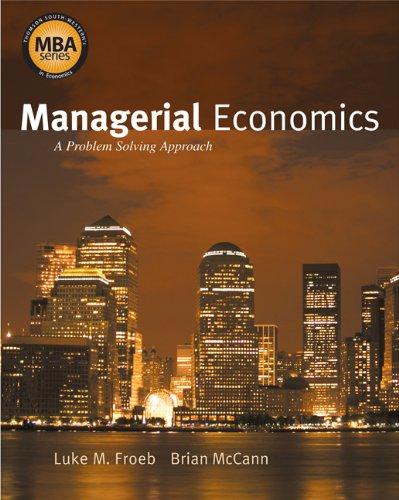Question
1, An innovation is the conception of a new product or process, along with the proof that it will work. TRUE OR FALSE 2, If
1, An innovation is the conception of a new product or process, along with the proof that it will work. TRUE OR FALSE
2, If a process innovation increases the economy (as opposed to the efficiency) of a process, it will increase profits by increasing revenue relative to costs. TRUE OR FALSE
3, If a product innovation results in a significant improvement over the existing products, the availability of good substitutes for that product will go down, thus making the demand curve for the improved product more elastic. TRUE OR FALSE
4, Which of the following inventions allowed for miniaturization?
A, The Bessemer Process
B, The electric battery
C, The transistor
D, The micro computer
5, In what year did Henry Ford implement the moving assemby line?
6, Suppose the widget industry consisted of ten firms. Acme, the largest company had a 40% share of the total market. Beta, the next larges, had a 20% share. Bill's Widget Corp. had a 10% share. And The U.S. Widget Corporation of America had a 5% share. The remaining six firms split up the other twenty five percent of the market. What was the four firm concentration ratio? Enter only the number, no percentage sign.
7, Refer to the question above. Suppose that these four firms were the only firms in the industry. What would be the Herfendahl Index?
8, Which of the following was most responsible for the industrial revolution in the United States?
A, The heavy plow
B, The automobile
C, The railroad
D, The electric light bulb
9, Capital intensive firms tend to become economies of scale at a higher level of output than labor intensive firms. TRUE OR FALSE
10, Capital is more of a variable cost to firms, while labor is more of a fixed cost. TRUE OR FALSE
11, Which of the following is not a valid statement about research and development?
| A. | A pure monopoly might not be inclined to invest in research and development because it is already maximizing its profits with no threat of competition because of insurmountable barriers to entry. | |
| B. | The expected rate of return on R&D may be low or even negative for a pure competitor due to the easy entry by other firms. | |
| C. | Unlike purely competitive firms, monopolistically competitive firms have little incentive to innovate because they maintain economic profits through barriers to entry. | |
| D. | The large size of oligopolists enables them to finance the often large R&D costs associated with major product or process innovation, and the existence of barriers to entry into the industry gives the oligopolist some assurance that it can maintain any economic profit it gains from innovation. |
12, If a firm's total costs is derived almost completely from fixed costs, a firm can reduce its average total costs by producing larger quantities of output.TRUE OR FALSE
13, Which market structures are likely to produce the greatest technological innovation and progress.
A, Pure monopoly and pure competition.
B, Pure competition and monopolistic competition C, Monopolistic competition and oligopoly
D, Oligopoly and pure monopoly
14, A cartel is:
A, A trust
B, A group of firms colluding to set prices and avoid competition
C, A group of sellers who cooperate, rather than compete
D, All of the above.
15, Which of the following was not addressed by the Clayton Act?
| A. | price discrimination | |
| B. | tying contracts | |
| C. | clarity in the rule of reason. | |
| D. | the establishment of the Federal Trade Commission |
16, Which of the following merger would be least likely to be in violation of the Cellar Kefauver Act of 1950?
A, VERTICAL B, Horizontal C, Conglomerate D, All would be equally likely
17, Fill the following questions with these numbers
1, benefits 2, capital 3, collusion 4, concentrated 5, per se 6, price
7, revenue 8, rule of reason 9, scale 10 technological

Step by Step Solution
There are 3 Steps involved in it
Step: 1

Get Instant Access to Expert-Tailored Solutions
See step-by-step solutions with expert insights and AI powered tools for academic success
Step: 2

Step: 3

Ace Your Homework with AI
Get the answers you need in no time with our AI-driven, step-by-step assistance
Get Started


